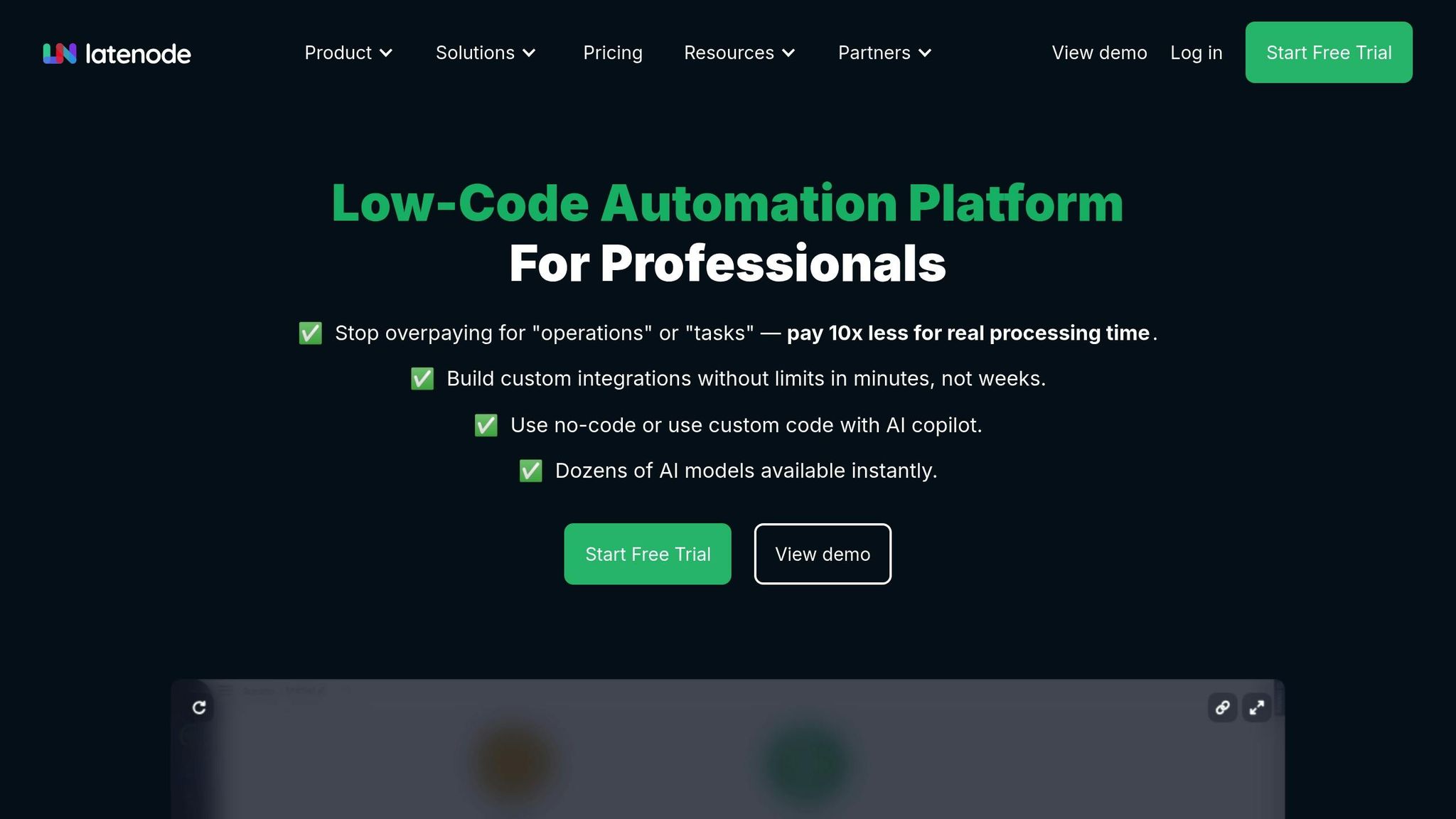


AI agents are transforming how businesses operate by automating tasks, processing data faster than humans, and making decisions autonomously. These systems are reshaping industries by reducing errors, cutting costs, and improving efficiency.
In this article, you'll learn how AI agents:
Platforms like Latenode simplify building these systems with low-code tools, enabling businesses to create custom automation workflows without deep technical expertise. Let’s break down the key components and use cases of AI agents.
AI agent systems use cutting-edge technologies to process information, make decisions, and automate tasks. By breaking down their core components, you can better understand how they bring value to businesses. Let’s start with how Natural Language Processing (NLP) enables these systems to interpret human language.
Natural Language Processing (NLP) allows AI agents to understand and respond to human language. It works by analyzing text, breaking down phrases, tagging parts of speech, identifying entities, and gauging sentiment.
NLP plays a growing role in business, with the global NLP market projected to hit $43.3 billion by 2025 [3]. This surge reflects its increasing use, as 70% of consumers now prefer chatbots for quick brand interactions [3]. After processing language inputs, machine learning steps in to enhance these abilities.
Machine learning helps AI agents improve over time by recognizing patterns and learning from data. Here are three key approaches they use:
Once trained, these systems rely on automation tools to carry out tasks efficiently.
Process automation tools allow AI agents to perform tasks and integrate into existing business systems. Common methods include:
To implement automation effectively, businesses can follow these steps: identify repetitive tasks, use pre-built templates, and gradually increase complexity [2]. With these tools, AI agents can handle tasks more efficiently and reliably.
These three components are at the core of automation in AI agent systems.
AI agents simplify complex operations by breaking them into smaller, manageable tasks using planning modules. These modules analyze overarching goals and divide them into actionable steps. The system then refines its approach through feedback loops, improving its performance over time [1]. Once tasks are organized, the system determines its next actions using predefined decision-making processes.
The decision-making abilities of AI agents vary based on their design. Each type of agent employs a specific strategy to evaluate information and decide on the best course of action. Here are some examples:
| Agent Type | Decision Method | Application |
|---|---|---|
| Model-Based Reflex | Uses internal models to interpret input | Self-driving cars adapting to road conditions |
| Goal-Based | Compares actions against set objectives | Delivery robots planning efficient routes |
| Utility-Based | Selects options to maximize overall benefit | Investment tools analyzing market trends |
| Learning | Adjusts decisions based on past experiences | Recommendation engines for e-commerce |
These methods allow agents to make decisions quickly and effectively [1].
AI agents rely on integrations with various software tools and databases to function efficiently. Key components include:
These integrations enable AI agents to link different business applications, facilitating seamless data flow and automation. For instance, in e-commerce, AI agents can analyze customer data across platforms to deliver personalized shopping recommendations based on purchase history [1].
The demand for such capabilities is reflected in market growth projections. The AI agent market is anticipated to grow from $5.1 billion in 2024 to $47.1 billion by 2030, highlighting the increasing need for automation solutions that integrate seamlessly with existing business systems [1].
AI agents are transforming how businesses operate, offering practical solutions for customer service, data management, and document processing. By automating routine tasks, they help organizations save time, reduce errors, and improve overall efficiency.
AI-driven customer service systems provide instant support, handling inquiries round the clock without the need for human intervention. Research shows that AI chatbots can address up to 80% of customer inquiries immediately [4].
For instance, in 2024, an AI agent was implemented to manage refund requests. This reduced resolution times from over 30 minutes to nearly instantaneous responses, boosting productivity by 500% and cutting processing time by over 80% [5]. These systems not only improve customer satisfaction but also free up human agents to focus on more complex issues.
AI agents are highly effective in managing data-related tasks. They can handle data entry, create detailed reports, monitor compliance, and detect anomalies in datasets. By automatically extracting information from unstructured sources and updating records across various platforms, these agents simplify workflows from data collection to storage, making processes more seamless and accurate.
Document workflows also benefit significantly from AI agents. In software development, for example, AI code assistants can generate documentation automatically, reducing manual effort and ensuring consistency.
Organizations can further enhance the performance of AI tools by training them with well-structured documentation and FAQs. At the same time, maintaining clear escalation paths to human support ensures that service quality remains high [4]. This balanced approach allows businesses to harness automation effectively while meeting customer expectations.

Workflow automation platforms blend low-code tools with AI to simplify repetitive tasks. These platforms enable organizations to build complex automation workflows without requiring deep technical knowledge. Latenode is a prime example, offering practical AI-driven solutions to enhance business automation.
Latenode's platform features a visual canvas where users can design workflows by linking components. Its AI Code Copilot assists in generating custom code, allowing users to build advanced automations with ease.
For instance, in September 2024, an education management team used Latenode to automate their Google Sheets form submissions. The workflow transferred data directly to their CRM, showcasing Latenode's low-code approach to seamless data handling.
Additional tools include a headless browser for automating web tasks and a built-in database for efficient data management. Islam B., CEO of a computer software company, highlighted its ease of use:
"AI Nodes are amazing. You can use it without having API keys, it uses Latenode credit to call the AI models which makes it super easy to use."
Latenode's pricing is based on execution time rather than task count, offering flexibility for businesses of all sizes. Below is a breakdown of the plans:
| Plan | Monthly Cost | Execution Credits | Active Workflows | History Retention |
|---|---|---|---|---|
| Free | $0 | 300 | 5 | 1 hour |
| Micro | $5 | 2,000 | 20 | 3 days |
| Start | $17 | 10,000 | 40 | 3 days |
| Grow | $47 | 50,000 | Unlimited | 30 days |
| Prime | $297 | 1.5M | Unlimited | 60 days |
This pricing model is ideal for businesses looking for affordable automation. Stockton F. shared his experience:
"I honestly love how Latenode has approached automation. The 'low-code' approach is perfect for my needs. I'm not a developer, but with the help of their AI helper I can get cool stuff done very quickly."
AI agent systems are transforming how businesses handle automation by simplifying workflows and managing complex tasks using natural language processing (NLP) and machine learning. These technologies are reshaping how companies improve operational efficiency and handle day-to-day challenges.
For instance, businesses utilizing AI agents in customer support have seen measurable improvements in response times and issue resolution rates. The rise of low-code platforms has made this shift even faster and more accessible. As Charles S., Founder of Small-Business, shares:
"My new best kept secret! My favorite things about LateNode are the user interface and the code editor. Trust me, being able to write 'some' of your own code makes a huge difference when you're trying to build automations quickly…"
- Charles S., Founder Small-Business
As adoption of AI agent systems continues to expand, businesses are discovering their potential to enhance efficiency and streamline operations. Latenode stands out in this space, offering a platform that empowers even those without extensive coding experience to create effective AI-driven solutions. Its visual interface and low-code tools make advanced automation accessible to businesses of all sizes, paving the way for broader adoption and innovation in automation.
Natural Language Processing (NLP) enhances AI assistants by enabling them to understand, interpret, and respond to human language in a natural and intuitive way. This allows businesses to streamline interactions, making communication with AI agents feel more conversational and user-friendly.
Key benefits of NLP in AI assistants include:
By leveraging NLP, AI assistants can improve productivity, automate workflows, and provide a seamless user experience, making them invaluable tools for modern business operations.
Machine learning (ML) plays a crucial role in helping AI agents become smarter and more effective over time. By analyzing large amounts of data, AI agents can identify patterns, learn from past experiences, and continuously refine their decision-making processes. This adaptability allows them to respond more accurately and efficiently to new challenges or tasks.
Through techniques like reinforcement learning, AI agents can improve their performance by receiving feedback on their actions and adjusting their behavior to optimize outcomes. Over time, this learning process enables AI systems to not only make better decisions but also adapt to evolving environments, making them invaluable tools for automating workflows and enhancing productivity.
Latenode makes it easy for businesses with limited technical skills to harness the power of AI for workflow automation. Its AI assistant, integrated within the JavaScript module, can help with tasks like writing, debugging, and modifying code based on simple requests. This allows users to create automations without needing advanced coding knowledge.
For example, the AI assistant can generate HTML for data collection forms or set up API integrations with tools like Trello, streamlining processes for beginners. With Latenode, even those new to automation can build efficient solutions to enhance productivity and save time.



